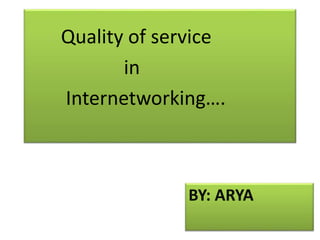
Quality of service
- 1. BY: ARYA Quality of service in Internetworking….
- 2. CONTENTS: • Data Traffic • Congestion • Congestion Control • Quality of Service • Techniques to improve QOS • How QOS is implemented within the Internet • References
- 3. DATA TRAFFIC • The main focus of congestion control and quality of service is data traffic. • In congestion control we try to avoid traffic congestion. • In quality of service, we try to create an appropriate environment for the traffic.
- 4. CONGESTION • Congestion in a network may occur if the load on the network (the number of packets sent to the network) is greater than the capacity of the network (the number of packets a network can handle). • Congestion control refers to the mechanisms and techniques to control the congestion and keep the load below the capacity.
- 5. CONGESTION CONTROL • Congestion control refers to techniques and mechanisms that can either prevent congestion, before it happens, or remove congestion, after it has happened. In general, we can divide congestion control mechanisms into two broad categories: open-loop congestion control (prevention) and closed- loop congestion control (removal).
- 6. The rapid growth of the Internet, and increasing levels of traffic, make it difficult for Internet users to enjoy consistent and predictable end to end levels of service quality. What causes poor service quality within the Internet? what are the components of service quality and how can they be measured?
- 7. QUALITY OF SERVICE • Quality of service is the overall performance of a telephony or computer network, particularly the performance seen by the users of the network. • The ability to provide different priority to different applications, users, or data flows • Guarrante a certain level of performance to a data flow. For example, a required bit rate, delay, jitter. • Something a flow seeks to attain.
- 9. Delay: Delay is the elapsed time for a packet to be passed from the sender, through the network, to the receiver. It is made of four components : propagation time, transmission time, queuing time and processing time. The higher the delay, the greater the stress that is placed on the transport protocol to operate efficiently. For example : Telephony, audio conferencing and video conferencing needs minimum delay. Jitter: Packets from the source will reach the destination with different delays. This variation in delay is known as jitter . Jitter causes the signal to be distorted and are unacceptable in situations where the application is real-time based, such as an audio or video signal. It can seriously affect the quality of streaming audio and/or video.
- 10. Bandwidth: Bandwidth is the maximal data transfer rate that can be sustained between two end points. Bit rate directly proportional to bandwidth. This is limited by the physical infrastructure of the traffic path within the transit networks . Different application needs different bandwidth. For example: In video conferencing we need to send millions of bits per sec while in e-mail we may not reach even a million. Reliability: Network reliability is measured by frequency of failure means how long it takes a link to recover from a failure. Lack of reliability means loss of packets or ACK. So, retransmission required. For example: e-mail, file transfer must have reliable transmission.
- 11. TECHNIQUES TO IMPROVE QUALITY OF SERVICE We briefly discuss four common methods: I. Scheduling. II. Traffic shaping. III. Admission control. IV. Resource reservation.
- 12. SCHEDULING Three techniques designed to improve quality of service: • FIFO Queuing. • Priority Queuing. • Weighted Fair Queuing.
- 15. 24.15 3. Weighted fair queuing
- 16. TRAFFIC SHAPING There are two techniques that can control the rate of traffic. • Leaky Bucket • Token Bucket.
- 19. 24.19 A leaky bucket algorithm shapes bursty traffic into fixed-rate traffic by averaging the data rate. It may drop the packets if the bucket is full. Note
- 21. 24.21 The token bucket allows bursty traffic at a regulated maximum rate. Note
- 22. How is Quality of service implemented within the Internet? The Internet is composed of a collection of routers and transmission links. Routers receive an incoming packet, determine the next hop interface, and place the packet on the output queue for the selected interface. Poor service quality is typically encountered when the level of traffic selecting a particular hop exceeds the transmission bandwidth of the hop for an extended period of time.
- 23. In such cases, the router's output queues associated with the saturated transmission hop begin to fill, causing additional transit delay (increased jitter and delay), until the point is reached where the queue is filled, and the router is then forced to discard packets (reduced reliability). This in turn forces adaptive flows to reduce their sending rate to minimize congestion loss, reducing the available bandwidth for the application. Poor service quality can be generated in other ways, as well. Instability in the routing protocols may cause the routers to rapidly alter their selection of the best next hop interface, causing traffic within an end to end flow to take divergent paths, which in turn will induce significant levels of jitter, and an increased probability of out of order packet delivery (reduced reliability).
- 24. References: • Data Communications & Networking by Behrouz A. Forouzan. • https://www.wikipedia.org